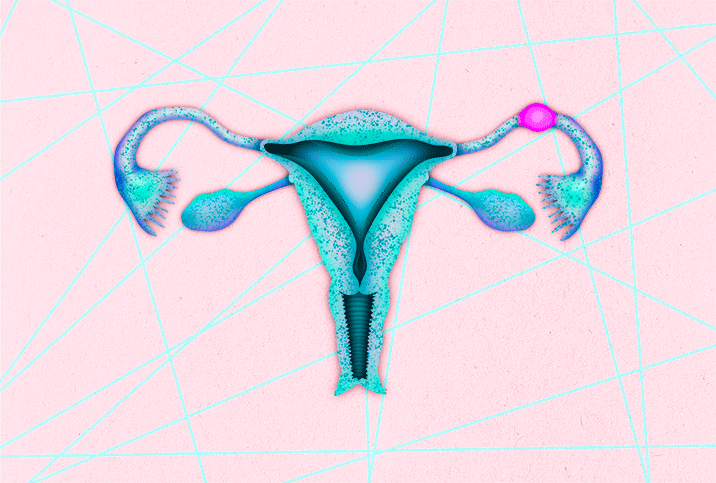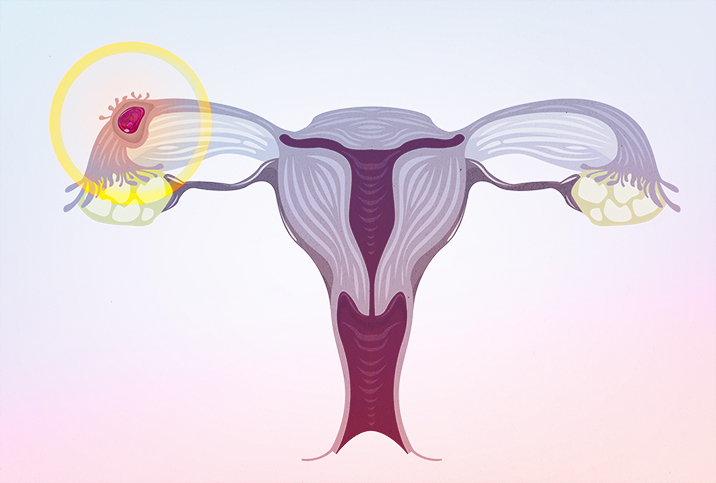The Fallopian Tube Enigma: Are They Attached to the Ovaries?

Contrary to what you may think, the fallopian tubes are not actually attached to the ovaries. (Mind-blowing, we know.) Some people describe them as "floating" inside the reproductive tract.
So, how does that work? How does the egg go from the ovaries to the fallopian tubes for ovulation if the parts aren't directly connected? We talked to experts for more information on the transient nature of one of your key reproductive body parts.
Why do we have fallopian tubes?
The anatomy of your reproductive system is complex, and the fallopian tubes (also known as uterine tubes or oviducts) play an important part.
"The fallopian tubes are located in the pelvis and serve as a slender tube which connects the ovaries to the uterus," explained Kecia Gaither, M.D., F.A.C.O.G., double board-certified in OB-GYN and Maternal-Fetal Medicine, and director of perinatal services at NYC Health + Hospitals/Lincoln in the Bronx.
One ovary and tube lie on each side of the uterus. The fallopian tubes' primary function is to help transport eggs from the ovaries to the uterus.
Attached or floating?
Ona Croft, a registered nurse working in General Practice in the United Kingdom, confirmed that the fallopian tubes are, in fact, not attached to the ovaries. They are, however, attached to the uterus.
"The funnel-like ends of the fallopian tubes open into the abdominal cavity and aren't directly connected to the ovaries," Croft said.
The ends of the fallopian tubes have fimbriae—which function like little fingers and have a sweeping function, Gaither added. When the ovary releases an egg, the fimbriae sweep it into the fallopian tube and then contractions move the egg toward the uterus.
According to Croft, if the egg is met by sperm, fertilization might occur en route to the uterus. The fertilized egg then continues toward the uterus—and if it implants in the uterus and continues to develop, it becomes a uterine pregnancy.
If fertilization of the egg does not occur, you discharge the egg and uterus lining via your period. Your body then prepares a new uterine lining, and another egg begins to mature within the ovary.
Can I still get pregnant with one fallopian tube
Many people are concerned that they may not be able to get pregnant if they only have one fallopian tube. However, Gaither advised that pregnancy can still occur.
"According to The Ectopic Pregnancy Trust, it is indeed possible for an egg to make it to the opposite tube, and is reportedly the case in one-third of pregnancies," Croft added.
Croft said the floating nature of the fallopian tubes actually maximizes the chance of successful reproduction in that it allows an egg to be picked up by the fallopian tube on the opposite side of the ovary. "This might not be possible if the fallopian tube was more robustly attached to the ovary," she said.
Fallopian tubes: What could wrong?
The most well-known condition associated with the fallopian tubes is ectopic pregnancy. An ectopic pregnancy occurs when a fertilized egg implants outside the uterus. This most commonly occurs in the fallopian tubes but can also happen in other locations, such as the ovary or abdominal cavity.
Unfortunately, an ectopic pregnancy can't proceed and survive. And, if left untreated, it can cause life-threatening internal bleeding.
The Ectopic Pregnancy Trust advises that this "is a common, life-threatening condition that is the leading cause of maternal death in the first trimester of early pregnancy." The condition affects approximately 1 in 80 pregnancies in the U.K., and there are "on average two deaths per year in the U.K. and Ireland due to ectopic pregnancy."
There are several other conditions that can also affect your fallopian tubes:
- Endometriosis is where tissue similar to the endometrium grows outside the uterus. It can grow in the ovaries, fallopian tubes, supporting uterine structure and the pelvic cavity lining.
- Salpingitis is inflammation of the fallopian tube and is commonly caused by pelvic inflammatory disease (PID), infections and sexually transmitted diseases (STD).
- Fallopian tube cancer is quite rare. It is similar to ovarian cancer but starts in the fallopian tubes.
- Hydrosalpinx is a fallopian tube filled with fluid that can cause infertility and ectopic pregnancy.
- Paratubal cysts are fluid-filled cysts that develop beside or near the ovary and fallopian tube but are not directly attached.
Since the fallopian tubes are an integral part of the reproductive system, all these conditions can cause issues with fertility. Problems such as a blocked fallopian tube or having one fallopian tube do not necessarily mean a life without children.


















